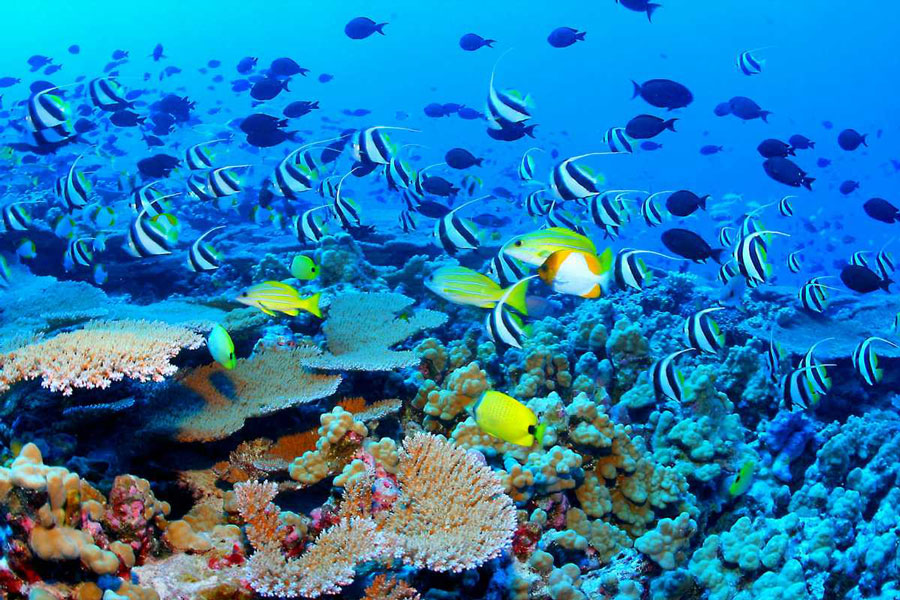Featured in Oceans
The coral reefs in New Calcedonia and the marine biodiversity here is so breathtaking that these corals and waters were featured in the movie Oceans, produced by Jacques Perrin.

The New Calcedonia Barrier Reef is located in New Calcedonia in the South Pacific Ocean. It is the second longest double barrier reef in the world. Belize’s double barrier reef is number one.
The New Calcedonia Reef surrounds the island of Grand Terre, the largest island in New Calcedonia and also circles around the Ile des Pins and other smaller islands. These reefs reach out into the sea some 19 miles from shore and extend 200 miles into the sea, running into the Entrecasteaux reefs.
There are some 150 species of coral here out of the 965 documented species total that are in existence in the world today. The Loyalty Island here is made of a very hard, porous coral that is quite unique.
This double barrier reef system reaches a length of 930 miles long and has a lagoon, which reaches depths of 82 feet.

The Spectacular Marine Diversity of New Calcedonia
This coral reef system of New Calcedonia has a very rich level of marine diversity. Scientists are simply taken aback from the marine species to be studied here. There are some 9,372 marine animals including rare and endemic species. Of these thousands of species, there are 1,965 species of fish, 454 species of marine plants, 4,000 species of crustaceans, and 2,150 species of mollusks.
See the Largest Shark (and Fish) in the Entire World
The New Calcedonia reefs are visited by humpback whales and whale sharks – and whale sharks are the largest shark in the world and is, in fact, larger than some whales. The reefs are also inhabited by various species of sea turtles, including hawksbill turtles, green turtles, leatherback turtles, loggerhead turtles, and the highly endangered Olive Ridley turtle, of which only 1,000 are in existence. The reefs are also home to the endangered dugong as well.
Unusually Brightly Colored Corals

The colors of the corals here are especially bright and unusual — virtually glowing in shades of orange and bluish-green. The interaction of these opposite colors on the color spectrum makes for quite a breathtaking scene.
New Calcedonia Receives The Coveted World Heritage of Humanity Award
In 2008, most of the New Calcedonia reef area was declared a World Heritage of Humanity by UNESCO. And these World Heritage awards are not easy to get. You have to satisfy strict criteria in all kinds of areas to be designated as one. Criteria for the Calcedonia Reefs that gave it this high designation include
- Superlative natural phenomena or natural beauty.
- Ongoing biological and ecological processes.
- And biological diversity and threatened species.
Other reefs that have been listed as World Heritage sites include the Apo Reef, the Belize Barrier Reef, and Great Barrier Reef.
Just Designated the Largest Marine Park in the World
New Calcedonia has something to be quite happy about. Just in May of 2014, the reefs and the surrounding Coral Sea area were declared the largest marine park in the world. The marine park will, of course, protect the reef from the kinds of damages unprotected reefs suffer such as overfishing and the dangers of ships, especially highly destructive ship anchoring processes.
The reefs here are in good health in New Calcedonia, but nickel mining on the Grand Terre Island and the runoff from this mining, which is full of dangerous chemicals, has taken its toll.
Some reefs have been completely buried in silt. Huge areas of mangrove trees have been destroyed, which worsens the problem of sedimentation, as these act as a barrier, absorbing sediment and helping protect the reefs from complete destruction.
The reefs also have a small problem with crown of thorns starfish, which are highly destructive animals to reefs. The reefs are also suffering from the erosion that occurs during cyclones.
